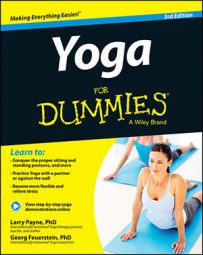When your body is warmed up, you can move into what are referred to as the main postures, the central part of the Yoga routine. Interspersed among the main postures are compensation postures, which allow your body to come back into balance after each main posture and prevent discomfort and injury.
Standard asanas
The main postures are the standard asanas you find featured in the classical Yoga texts and modern manuals. These asanas are the stars of your routine, requiring you to work a little harder. Whichever asanas you select, remember to match them with your specific goals.
![[Credit: Photograph by Adam Latham]](https://www.dummies.com/wp-content/uploads/431993.image0.jpg)
Whenever possible, a warm-up posture precedes and a compensation posture follows each category of main postures.
The number of postures you select for your Yoga session depends on your available time and your goals. You will want to create routines that focus on general conditioning, stress reduction, preparation for meditation, and a quick pick-me-up.
Compensation postures
Compensation is part of bringing you back into balance, which is a key concept in Yoga. Use compensation postures to unwind or bring your body back into neutral, especially after strenuous postures.
Some basic guidelines are useful with compensation postures:
Use one or two simple compensation postures to neutralize tension you feel in any area of the body after a Yoga posture or sequence.
Always use conscious breathing.
Perform compensating postures that are simpler or less difficult than the main posture right after the main posture. Do them dynamically.
Don’t follow a strenuous posture with another strenuous posture in the opposite direction. Some Yoga instructors teach the fish posture as compensating for the shoulder stand. However, this combination can cause problems, especially for beginners, so the less strenuous cobra posture is recommended instead.
Use compensation postures even when you feel no immediate need for them, especially after deep back bends, twists, and inverted postures.
Gentle forward bends typically compensate back bends, twists, and side bends.
Many forward bends are self-compensating. However, you may want to follow with gentle back bends after doing a lot of forward bending.
Rest after strenuous postures, such as inverted postures or deep back bends, before beginning the compensation postures.
Following are some great compensation postures.
The dynamic cat
The dynamic cat is a nice compensation posture for twists, but you can also use it as a warm-up.
Starting on your hands and knees, look straight ahead.
Place your knees at hip width, with your hands below your shoulders.
Straighten but don’t lock your elbows.
As you exhale, sit back on your heels and look at the floor.
![[Credit: Photograph by Adam Latham]](https://www.dummies.com/wp-content/uploads/431994.image1.jpg) Credit: Photograph by Adam Latham
Credit: Photograph by Adam LathamAs you inhale, slowly return to the starting position in Step 1.
Again, look straight ahead.
Repeat Steps 3 and 4 six to eight times.
Dynamic knees-to-chest
You can find many variations of knees-to-chest, but this variation is especially good after back bends.
Lie on your back, and bend your knees toward your chest.
Hold your legs just below your knees, with one hand on each leg.
If you have any knee problems, be sure to hold the backs of your thighs.
As you exhale, draw your knees toward your chest.
![[Credit: Photograph by Adam Latham]](https://www.dummies.com/wp-content/uploads/431995.image2.jpg) Credit: Photograph by Adam Latham
Credit: Photograph by Adam LathamAs you inhale, move your knees away from your chest.
Repeat Steps 3 and 4 six to eight times.
Thunderbolt posture: Vajrasana
This exercise is useful for compensation or warm-up. Vajra (pronounced vahj-rah) means both “diamond/adamantine” and “thunderbolt.”
Kneel on the floor, with your knees and feet at hip width.
Sit back on your heels, and bring your back up nice and tall. Hang your arms close to your sides.
As you inhale, lift your hips back up and sweep your arms up over your head; lean back and look up.
As you exhale, sit on your heels again, fold your chest to your thighs, and bring your arms behind your back.
Get into a nice flow: Inhale when you open, exhale when you fold.
Repeat Steps 3 and 4 six to eight times.
Don’t perform the thunderbolt if you have knee problems.
![[Credit: Photograph by Adam Latham]](https://www.dummies.com/wp-content/uploads/431996.image3.jpg)

